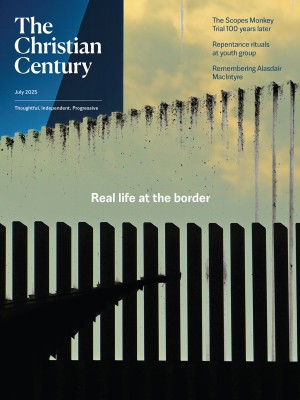Learning humility as a student pastor
Field education invites us to the lifelong work of discovering the Holy Spirit through our stunning inadequacies.

Photo by Smitt / iStock / Getty
The congregation stood in a circle, their eyes turned toward me as I spoke the words of institution: “For I received from the Lord what I also passed on to you: the Lord Jesus, on the night he was betrayed, took bread.” I raised the round loaf. Tearing it down the center, I continued. “This is my body, which is broken for you.”
At that moment, a clove of garlic fell from the torn bread and landed at my feet.
That summer I was a field education student at a small Mennonite church in north Philadelphia, completing an internship required for the master of divinity degree. During those months, I preached, supported the church’s community development organization, planned youth group events, and visited church members in their homes.
Read our latest issue or browse back issues.
On that humid July morning, I was tasked with presiding over communion, and it was the job of the presider to procure the elements before the service. On my way to worship, I’d stopped at the local Whole Foods where, in a hurry, I’d grabbed a round boule in a plastic bag and a bottle of grape juice from the shelf. I hadn’t noticed the label: “enriched white bread, whole garlic cloves.”
Over the summer, hundreds of churches across the country welcome student pastors to learn and grow among them. The churches that host student pastors offer more than a laboratory to try out what seminarians learn in the classroom. They offer future pastors a space to discover their identity and explore their limitations. Field education placements invite pastors to the lifelong work of discovering the Holy Spirit through our stunning inadequacies.
Student pastors have many occasions to discover their humility. Field education is often a summer of firsts. The first time facing down a group of kids during a children’s sermon. The first time not knowing what to say to a grieving parent. The first time getting on the wrong side of the finance committee chair. We discover, as Richard Neuhaus once wrote, that “the minister is expected to be preacher, leader of worship, counselor, teacher, scholar, helper of the needy, social critic, administrator, revivalist, fund-raiser, and a host of other sometimes impossible things.” We come achingly close to our humanness, to our vulnerability before the task of ministry.
Field education isn’t designed for humiliation. But at their best, the encounters with “impossible things” that it offers can return us to dependency on God and on the church that holds us. Another time during my summer placement, I was asked to visit a baby and his family at the Children’s Hospital of Philadelphia. The one-year-old admitted to the hospital the previous day had been born with life-threatening and persistent allergic reactions, the extent of which was still unknown.
At the time I was especially attuned to the vulnerability of children. I was pregnant with my second child, and a recent ultrasound had revealed a cyst inside the fetus’s choroid plexus. Our midwife explained that the cyst would most likely resolve on its own, but there was a chance its presence indicated trisomy 18, a life-ending chromosomal difference. That summer and my field education were marked by tense waiting and worry.
At CHOP I parked my car, showed my ID, received my visitor’s pass, and made my way through the maze of the hospital. I passed through corridors lined with massive photographs of children treated there: a toddler bald from cancer treatments, an infant smiling through a nasal cannula, a family surrounding a teenager with Down syndrome. While the pictures were designed to invoke hope and resilience, I saw echoes of my own child’s potential diagnosis. By the time I reached the room, surging with pregnancy hormones and empathy, I was in tears.
What am I doing here? I wondered. I had no business offering comfort or counsel to the people inside the room. I gathered myself before pushing open the door and stepping inside.
The mother of the baby sat in a chair texting while her son played on a blanket. He smiled up at me as I walked in the door. As I sat down the boy’s mother caught my eye. “Are you okay?” She placed her hand on my shoulder as I explained how vulnerable this place made me feel and how I felt like I was letting her down as a pastoral presence.
She smiled and gently reminded me that CHOP was a regular part of their lives. She was surprised to see me—“We’re here all the time.”
Any illusions I harbored as to my role in caring for this family evaporated. They didn’t expect an answer that unraveled the riddle of human suffering. My image of the pastor—comforting a distraught mother, stepping outside herself as a pillar of strength—disappeared. I was one link in a chain of care that began the moment this baby was born, when church members brought meals, when they rushed to babysit the first time the family called 911, when emergency turned to routine.
It’s been many years since I walked pregnant and crying through the halls of CHOP. I’ve cultivated the boundaries required for pastors to emotionally and spiritually withstand the devastations of pastoral care. I’ve learned how to walk toward disaster, toward conflict, toward crisis. I’ve preached good sermons and mediocre sermons, knowing that a hundred more opportunities to preach lie before me. While sometimes I have known just what to say, I have also discovered that, at times, having no words is what the Spirit offers.
And I remember my first church as a pastor, my first communion, how when the bread was broken and the smell of garlic saturated the air, no one in the circle of the congregation flinched. I remember how each person took the torn loaf in their hands, cloves and all, and passed it from hand to hand repeating the ancient words: “The body of Christ, broken for you.”






